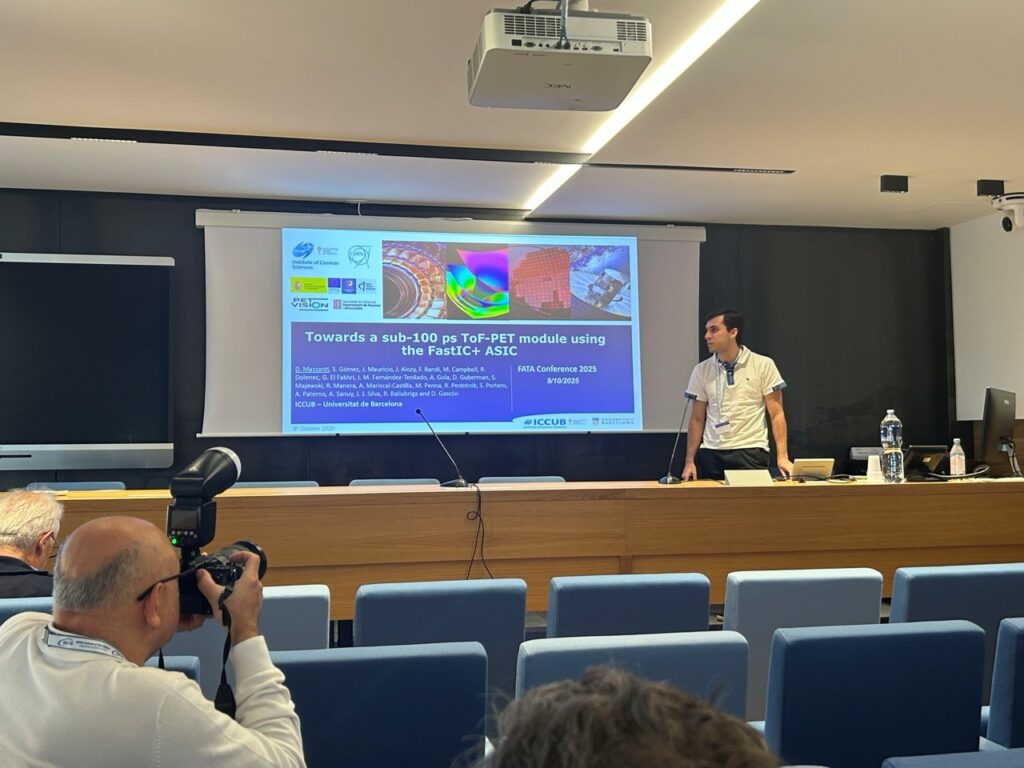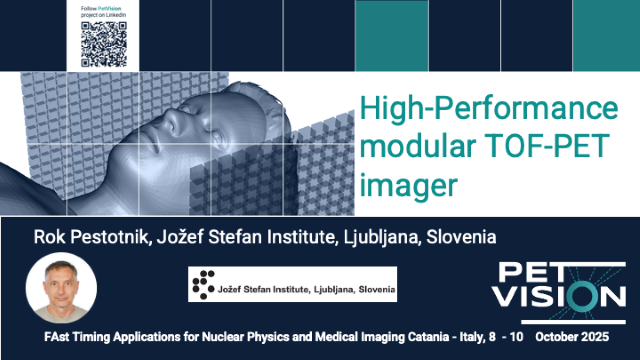We’re delighted to share that the 𝐏𝐞𝐭𝐕𝐢𝐬𝐢𝐨𝐧 𝐏𝐫𝐨𝐣𝐞𝐜𝐭 was represented at the 𝐅𝐀𝐬𝐭 𝐓𝐢𝐦𝐢𝐧𝐠 𝐀𝐩𝐩𝐥𝐢𝐜𝐚𝐭𝐢𝐨𝐧𝐬 (𝐅𝐀𝐓𝐀) 2025 𝐖𝐨𝐫𝐤𝐬𝐡𝐨𝐩 (agenda.infn.it/event/35107) — a key forum connecting cutting-edge developments in 𝐟𝐚𝐬𝐭 𝐭𝐢𝐦𝐢𝐧𝐠 𝐭𝐞𝐜𝐡𝐧𝐨𝐥𝐨𝐠𝐢𝐞𝐬 across 𝐧𝐮𝐜𝐥𝐞𝐚𝐫 𝐩𝐡𝐲𝐬𝐢𝐜𝐬 and 𝐦𝐞𝐝𝐢𝐜𝐚𝐥 𝐢𝐦𝐚𝐠𝐢𝐧𝐠.
Prof. Rok Pestotnik (Jozef Stefan Institute, Slovenia) delivered a 𝐤𝐞𝐲𝐧𝐨𝐭𝐞 𝐭𝐚𝐥𝐤 presenting the PetVision concept — a 𝐦𝐨𝐝𝐮𝐥𝐚𝐫, 𝐡𝐢𝐠𝐡-𝐩𝐞𝐫𝐟𝐨𝐫𝐦𝐚𝐧𝐜𝐞 𝐓𝐎𝐅-𝐏𝐄𝐓 𝐢𝐦𝐚𝐠𝐢𝐧𝐠 𝐩𝐥𝐚𝐭𝐟𝐨𝐫𝐦 developed under the 𝐄𝐔 𝐇𝐨𝐫𝐢𝐳𝐨𝐧 𝐄𝐮𝐫𝐨𝐩𝐞 𝐄𝐈𝐂 𝐏𝐚𝐭𝐡𝐟𝐢𝐧𝐝𝐞𝐫 𝐩𝐫𝐨𝐠𝐫𝐚𝐦𝐦𝐞. His presentation showcased progress toward achieving sub-100 ps timing resolution with flat-panel detector modules, paving the way for compact, cost-efficient, and mobile PET systems.
🔬 David Mazzanti Tarancón (Universitat de Barcelona, Institute of Cosmos Sciences (ICCUB)) also presented advances on 𝐅𝐚𝐬𝐭𝐈𝐂+, a next-generation front-end ASIC enabling 𝐬𝐮𝐛-100 𝐩𝐬 𝐜𝐨𝐢𝐧𝐜𝐢𝐝𝐞𝐧𝐜𝐞 𝐭𝐢𝐦𝐢𝐧𝐠 in PET modules — a crucial step toward scalable, low-power readout for future large-area TOF-PET detectors.
Together, these contributions highlight PetVision’s collaborative mission to 𝐫𝐞𝐝𝐞𝐟𝐢𝐧𝐞 𝐏𝐄𝐓 𝐢𝐦𝐚𝐠𝐢𝐧𝐠 through innovations in 𝐝𝐞𝐭𝐞𝐜𝐭𝐨𝐫 𝐝𝐞𝐬𝐢𝐠𝐧, 𝐒𝐢𝐏𝐌 𝐫𝐞𝐚𝐝𝐨𝐮𝐭 𝐞𝐥𝐞𝐜𝐭𝐫𝐨𝐧𝐢𝐜𝐬, 𝐚𝐧𝐝 𝐬𝐲𝐬𝐭𝐞𝐦 𝐢𝐧𝐭𝐞𝐠𝐫𝐚𝐭𝐢𝐨𝐧 — bridging the gap between fundamental detector R&D and clinical translation.


